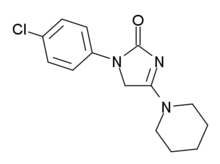ELB-139
 | |
| Identifiers | |
|---|---|
| |
| CAS Number | |
| PubChem CID | |
| ChemSpider | |
| CompTox Dashboard (EPA) | |
| Chemical and physical data | |
| Formula | C14H16ClN3O |
| Molar mass | 277.749 g/mol g·mol−1 |
| 3D model (JSmol) | |
| |
| |
| (verify) | |
ELB-139 (LS-191,811) is an anxiolytic drug with a novel chemical structure, which is used in scientific research. It has similar effects to benzodiazepine drugs, but is structurally distinct and so is classed as a nonbenzodiazepine anxiolytic.[1][2]
ELB-139 is a subtype-selective partial agonist at GABAA receptors, with highest affinity for the α3 subtype, but highest efficacy at α1 and α2.[3] It has primarily anxiolytic and anticonvulsant effects, but produces little sedative effects or ataxia,[4] and has also been demonstrated in rats to increase serotonin levels in the striatum and prefrontal cortex, without affecting dopamine levels.[5] It has been proposed as a possible candidate for a novel non-sedating anxiolytic or anticonvulsant drug for use in humans[6] The sponsor elbion AG registered a clinical trial in ClinicalTrials.gov for the treatment of anxiety associated with panic disorder but the results have not been reported.[7] It was developed by Arzeitmittelwerk Dresden in the 1990s.[8]
References
- ^ Langen, B; Egerland, U; Bernöster, K; Dost, R; Unverferth, K; Rundfeldt, C (2005). "Characterization in rats of the anxiolytic potential of ELB139 1-(4-chlorophenyl)-4-piperidin-1-yl-1,5-dihydro-imidazol-2-on, a new agonist at the benzodiazepine binding site of the GABAA receptor". The Journal of Pharmacology and Experimental Therapeutics. 314 (2): 717–24. doi:10.1124/jpet.105.084681. PMID 15860576.
- ^ Atack, JR (2005). "The benzodiazepine binding site of GABA(A) receptors as a target for the development of novel anxiolytics". Expert Opinion on Investigational Drugs. 14 (5): 601–18. doi:10.1517/13543784.14.5.601. PMID 15926867.
- ^ Rabe, H; Kronbach, C; Rundfeldt, C; Lüddens, H (2007). "The novel anxiolytic ELB139 displays selectivity to recombinant GABA(A) receptors different from diazepam". Neuropharmacology. 52 (3): 796–801. doi:10.1016/j.neuropharm.2006.09.013. PMID 17087982.
- ^ Grunwald, C; Rundfeldt, C; Lankau, HJ; Arnold, T; Höfgen, N; Dost, R; Egerland, U; Hofmann, HJ; Unverferth, K (2006). "Synthesis, pharmacology, and structure-activity relationships of novel imidazolones and pyrrolones as modulators of GABAA receptors". Journal of Medicinal Chemistry. 49 (6): 1855–66. doi:10.1021/jm0509400. PMID 16539371.
- ^ Langen, B; Rundfeldt, C (2007). "ELB139 an agonist at the benzodiazepine binding site increases 5-HT in the striatum and prefrontal cortex of rats: a microdialysis study". Pharmacology, Biochemistry, and Behavior. 86 (1): 79–85. doi:10.1016/j.pbb.2006.12.010. PMID 17257662.
- ^ Rogawski, MA (2006). "Diverse mechanisms of antiepileptic drugs in the development pipeline". Epilepsy Res. 69 (3): 273–294. doi:10.1016/j.eplepsyres.2006.02.004. PMC 1562526. PMID 16621450.
- ^ Whiting, PJ (2006). "GABA-A receptors: a viable target for novel anxiolytics?". Current Opinion in Pharmacology. 6 (1): 24–9. doi:10.1016/j.coph.2005.08.005. PMID 16359919.
- ^ US Patent 5869481 Anticonvulsive 1-ar(alk)ylimidazolin-2-ones and process for making
